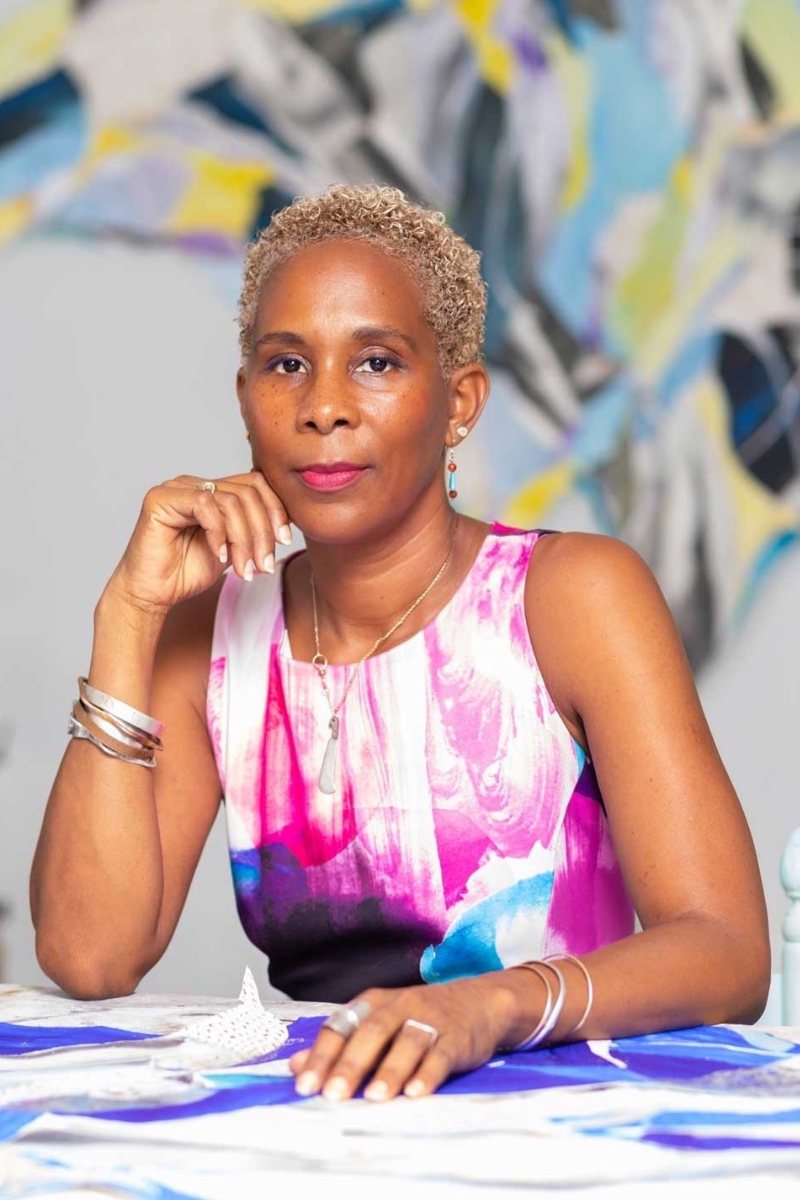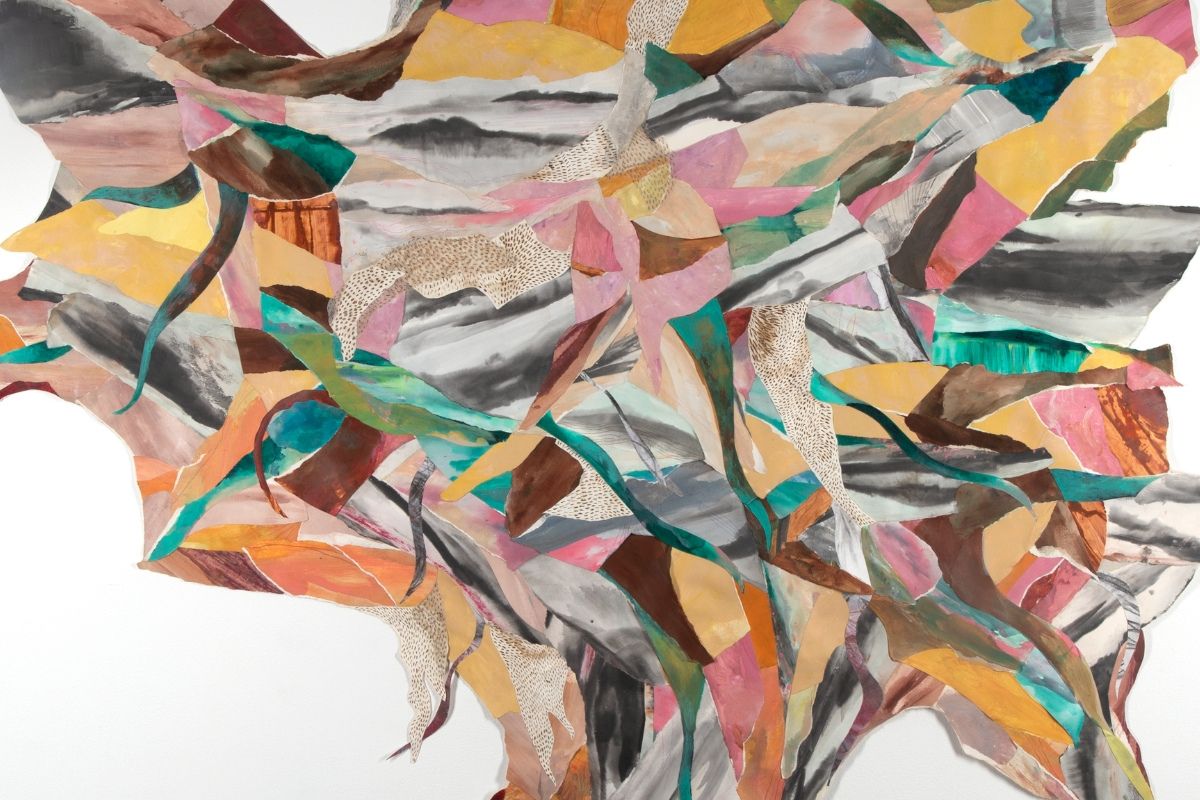It started, like many storms, with palm trees waving in the wind.
You can still catch glimpses of these images in the gray and white swaths that populate the collage titled “Storm (how to imagine the tropicalia as monumental — as in a memory that cuts like rivers.)”
The piece is part of the exhibit “Come Ruin or Rapture” by multidisciplinary artist La Vaughn Belle, on display at the Michael C. Carlos Museum through Dec. 8.
“In 2016, I was thinking about how the Caribbean is often represented,” says Belle, who lives in the U.S. Virgin Islands. “It’s often through a landscape that’s seemingly pristine and virginal, this image of paradise.”

Works from two series by artist La Vaughn Belle comprise the “Come Ruin or Rapture” exhibit.
It was a way to consider “what it feels like to be in a colonized space,” says Belle. “You’re in kind of a constant storm.” In this way, she adds, the trees also reference the Black body as something that’s always “bending, immutable, but not breaking.”
And so, she drew. Tree after tree, in storm after two-dimensional storm.
Then the real storms hit.
In quick succession, Hurricanes Irma and Maria devastated the Caribbean in 2017, damaging Belle’s studio, including her collection of paper, even paper she’d secured in plastic.
“A few years later, when I tried to use it, it was brittle, and I was surprised!” she recalls. “But in this place, everything absorbs the storm.”
Realizing it had been transformed into an artifact from the hurricanes, Belle went on to use the brittle, breaking paper to draw more storm trees, incorporating swaths of those drawings into larger works to play with a “larger aesthetic of ruin.” The result was the collage series “Storm (How to imagine the tropicalia as monumental).”
“The opportunity to have La Vaughn Belle’s work here at Emory is very special,” says curator Clinton Fluker, senior director of culture, community and partner engagement with the Carlos Museum and Emory Libraries. “She’s not dictating ideas, but she is starting conversations through her themes.” Fluker curated “Come Ruin or Rapture,” which has a counterpart exhibit at Clark-Atlanta University. Both were part of the “dECOlonial Feelin” symposium earlier this year.
The shape and colors of life
“This piece,” she says, of the collage pictured above, “is where I really started incorporating color.”
First, she worked in a “very minimal” burnt sienna. “And then I just started really exploring.”
“When I look at this now, I see the insides of conch shells,” she says. “I see flesh tones. I see sunset colors, sunrise colors and maybe, like, the inside of a plant, these beautiful greens with a little purple.”
Then, there’s the shape. “This one has these tendrils,” says Belle. “It almost feels like it’s scampering, like it’s moving.”
What animal is this colorful beast? None. Or all, says Belle.
“I mean, it could be everything, from a crab to an octopus, right? It’s all of the creatures together.” Or it’s its own creature, pulling from “the aesthetics of every other creature, including humans.”
Cuts and burns
Then there are the ribbons of white paper dotted with intricate lines of brown dashes that loop their way through “Storm.”
It’s a part of the story that starts, not with wind and waves, but with flames.
On the island of St. Croix, she notes, historic buildings from the 18th century stand side-by-side with newer architecture. One reason is that rebelling laborers set fires during events like the uprising of 1878, an event known locally as “Fireburn.”
The concentric patterns of burned-out cuts that weave through these pieces echo “the marks of rebellion,” as Belle puts it, calling to mind the farming tools used by laborers as weapons: the cane bill. The machete. The cutlass.
“In many of our colonial archives,” says Belle, “this resistance history isn’t there. I wanted to try to capture it.”
New maps
A few years ago, Belle took her family to Denmark, which colonized the Virgin Islands for more than two centuries. As tourists, she says they came across “this huge, really large map of the world.” Like most people do, Belle and her children immediately went to their part of the world, searching the map for home.
“But the Virgin Islands weren’t even marked,” she says.
“And I think a lot of my work has also been about making visible both my own history and this larger history. I’m almost creating new maps, another kind of map.”
“Come Ruin or Rapture” is about more than just extremes. It’s about the indomitable human spirit, she says. “Like: ‘Here we are, and we’re going to keep being.’”
Like that palm tree bending in the breeze.

